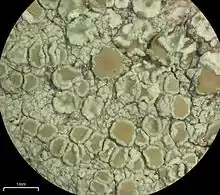Lecanora strobilina
Lecanora strobilina, also known as the mealy rim lichen, is a species of crustose lichen in the family Lecanoraceae. It was originally described as Parmelia strobilina by German botanist Kurt Polycarp Joachim Sprengel in 1827.[2] It is distributed across North America and the Mediterranean but has become established in South America and the Galapagos. [3] It can be distinguished from other closely-related species in the genus (including L. confusa) by the presence of the polyphenolic compound decarboxysquamatic acid in thin-layer chromatography (TLC).[4]
| Lecanora strobilina | |
|---|---|
 | |
| Scientific classification | |
| Domain: | Eukaryota |
| Kingdom: | Fungi |
| Division: | Ascomycota |
| Class: | Lecanoromycetes |
| Order: | Lecanorales |
| Family: | Lecanoraceae |
| Genus: | Lecanora |
| Species: | L. strobilina |
| Binomial name | |
| Lecanora strobilina (Spreng.) Kieff. (1895) | |
| Synonyms[1] | |
| |
References
- "Synonymy: Lecanora strobilina (Spreng.) Kieff". Species Fungorum. CAB International. Retrieved 2015-11-01.
- Sprengel, C. (1827). Caroli Linnaei systema vegetabilium (in Latin). Göttingen, Sweden: Sumtibus Librariae Dieterichianae. p. 300.
- Bungartz, Frank; Elix, John A.; Printzen, Christian (4 February 2020). "Lecanoroid lichens in the Galapagos Islands: the genera Lecanora, Protoparmeliopsis, and Vainionora". Phytotaxa. 431 (1) – via Biotaxa.
- Nash, T.H. III; Ryan, B.D; Gries, C.; Bungartz, F.; Diedrich, P. (2004). Lichen Flora of the Greater Sonoran Desert, Vol. 2. Lichens Unlimited. ISBN 0971675910.
This article is issued from Wikipedia. The text is licensed under Creative Commons - Attribution - Sharealike. Additional terms may apply for the media files.